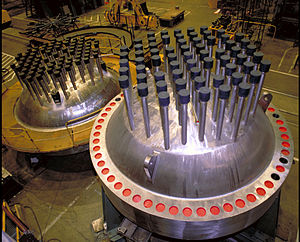
Back مفاعل الماء المضغوط Arabic Вода-вадзяны ядзерны рэактар Byelorussian Вода-вадзяны ядзерны рэактар BE-X-OLD চাপযুক্ত জল চুল্লি Bengali/Bangla Reactor d'aigua pressuritzada Catalan Tlakovodní reaktor Czech Druckwasserreaktor German Αντιδραστήρας πεπιεσμένου ύδατος Greek Premakva reaktoro Esperanto Reactor de agua a presión Spanish
A pressurized water reactor (PWR) is a type of light-water nuclear reactor. PWRs constitute the large majority of the world's nuclear power plants (with notable exceptions being the UK, Japan and Canada). In a PWR, the primary coolant (water) is pumped under high pressure to the reactor core where it is heated by the energy released by the fission of atoms. The heated, high pressure water then flows to a steam generator, where it transfers its thermal energy to lower pressure water of a secondary system where steam is generated. The steam then drives turbines, which spin an electric generator. In contrast to a boiling water reactor (BWR), pressure in the primary coolant loop prevents the water from boiling within the reactor. All light-water reactors use ordinary water as both coolant and neutron moderator. Most use anywhere from two to four vertically mounted steam generators; VVER reactors use horizontal steam generators.
PWRs were originally designed to serve as nuclear marine propulsion for nuclear submarines and were used in the original design of the second commercial power plant at Shippingport Atomic Power Station.
PWRs currently operating in the United States are considered Generation II reactors. Russia's VVER reactors are similar to US PWRs, but the VVER-1200 is not considered Generation II (see below). France operates many PWRs to generate the bulk of its electricity.
© MMXXIII Rich X Search. We shall prevail. All rights reserved. Rich X Search
